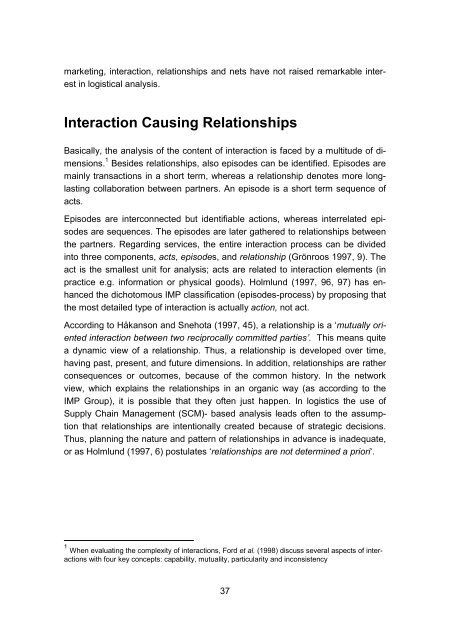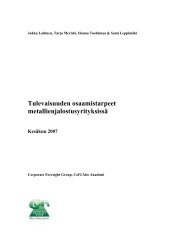849954 sisus
849954 sisus
849954 sisus
Create successful ePaper yourself
Turn your PDF publications into a flip-book with our unique Google optimized e-Paper software.
marketing, interaction, relationships and nets have not raised remarkable interest<br />
in logistical analysis.<br />
Interaction Causing Relationships<br />
Basically, the analysis of the content of interaction is faced by a multitude of dimensions.<br />
1 Besides relationships, also episodes can be identified. Episodes are<br />
mainly transactions in a short term, whereas a relationship denotes more longlasting<br />
collaboration between partners. An episode is a short term sequence of<br />
acts.<br />
Episodes are interconnected but identifiable actions, whereas interrelated episodes<br />
are sequences. The episodes are later gathered to relationships between<br />
the partners. Regarding services, the entire interaction process can be divided<br />
into three components, acts, episodes, and relationship (Grönroos 1997, 9). The<br />
act is the smallest unit for analysis; acts are related to interaction elements (in<br />
practice e.g. information or physical goods). Holmlund (1997, 96, 97) has enhanced<br />
the dichotomous IMP classification (episodes-process) by proposing that<br />
the most detailed type of interaction is actually action, not act.<br />
According to Håkanson and Snehota (1997, 45), a relationship is a ‘mutually oriented<br />
interaction between two reciprocally committed parties’. This means quite<br />
a dynamic view of a relationship. Thus, a relationship is developed over time,<br />
having past, present, and future dimensions. In addition, relationships are rather<br />
consequences or outcomes, because of the common history. In the network<br />
view, which explains the relationships in an organic way (as according to the<br />
IMP Group), it is possible that they often just happen. In logistics the use of<br />
Supply Chain Management (SCM)- based analysis leads often to the assumption<br />
that relationships are intentionally created because of strategic decisions.<br />
Thus, planning the nature and pattern of relationships in advance is inadequate,<br />
or as Holmlund (1997, 6) postulates ‘relationships are not determined a priori‘.<br />
1 When evaluating the complexity of interactions, Ford et al. (1998) discuss several aspects of interactions<br />
with four key concepts: capability, mutuality, particularity and inconsistency<br />
37








